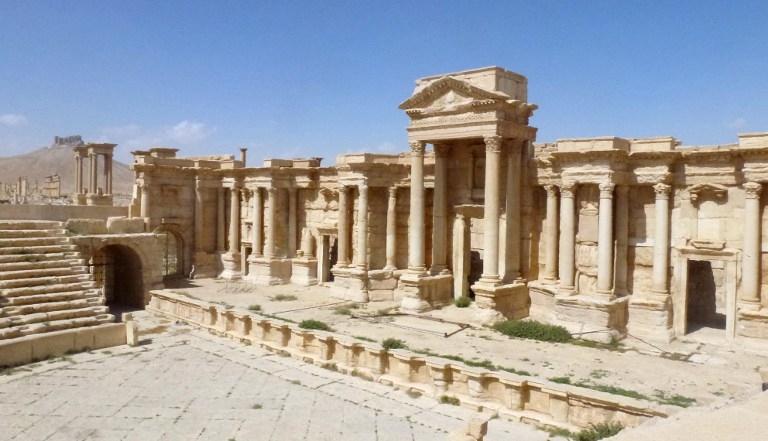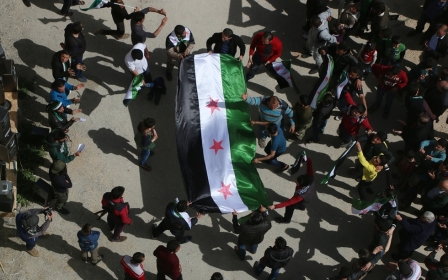Palmyra and propaganda: Assad's latest game

Brutal regimes like soft power. In Egypt they have beaches, camels and pyramids. In China they have pandas. Russia has glamorous fur-clad women. These are the things dictators like to see on our television screens, shifting the focus from their iniquity.
Palmyra is part of the propaganda machine of President Bashar al-Assad. He has carefully engineered the retaking of the ancient UNESCO World Heritage site this weekend to lull us into the sense that he cares deeply about Syria’s history.
The Syrian state news is currently chock-a-block with announcements of congratulatory calls between ministers about the victory at the "Pearl of the Desert".
We were shown pictures of the havoc wreaked inside the site’s museum, again supposedly by the Islamic State (IS) militant group – a cue to tut at the baddies and hail the Assad victory all round. One Russian news website has already reported that the Hermitage Museum in St Petersburg will help to restore Palmyra.
Assad himself was quoted as saying that Palmyra "will be restored again so as to remain a cultural heritage and treasure for the entire world".
And so we whoop and cheer, alongside figures such as the mayor of London, Boris Johnson, obviously attached to Palmyra, with good reason. He congratulated Assad on the victory over IS. The president in the suit, with the shiny shoes, has triumphed over the bearded, gun-toting men from Syria’s lawless north.
It is undoubtedly true that some of Assad’s museums and antiquities directorate staff care deeply about the site and the millennia of heritage that lie in this part of the Fertile Crescent. Syria’s rich museum collections have been boxed up, protecting them from the army barrel bombs that blast lethal detritus from the sky. At the 13th century Aleppo Citadel, under regime control, bas-reliefs have been protected by sand bags, to prevent them cracking under rebel fire.
The respected archaeologist, Khaled al-Asaad, died for the cause. IS beheaded him, reportedly after he refused to reveal where Palmyra’s artefacts had been locked away.
But really, the Pearl of the Desert is another pawn in Assad’s game. He and his soldiers do not care.
Why would they, when they too contributed to Palmyra’s destruction, alongside Syria’s other UNESCO-listed sites? Why would they, when they have bombed its khans, souqs and hammams, and its people’s Ottoman-era houses, so tenderly restored before the conflict?
Archaeology groups documented extensive damage to Palmyra before May 2015, when IS soldiers moved in.
A UN report from 2014 noted that military berms, embankments and roads had been built across the site, with earth stacked up for protecting tanks and heavy artillery.
There is much evidence that the museum and ruins had been looted while under the control of Syrian regime troops, before IS took over: local archaeologists and activists documented stolen busts and emptied chambers.
One Syrian archaeologist said this week that Palmyra was still at great risk under Assad, thanks to the risk of looting by the Syrian Army. The damage they had caused during their occupation led to the loss of artefacts and information equal to or greater than the loss of the Temple of Bel under IS.
That was a view shared by another Syrian from the opposition whom I contacted this week: "The destruction of Syria’s heritage by the regime is the same as Daesh" - referring to IS. They just don’t video it.
In Aleppo, one of the world’s oldest cities, aerial bombardment and gun battles have caused utter devastation to heritage sites.
The same UN report concluded that a fifth of the heritage sites it could identify from aerial footage had been totally destroyed. Video footage has showed centuries-old bath houses and mosques smashed to pieces. Many blame regime tanks for the destruction of the minaret of the city’s Great Mosque, which collapsed during battle in 2013.
Some of the damage to heritage is inevitably down to rebel groups: no side is innocent in the war, and in Aleppo observers hold both sides to blame for parts of the damage. That doesn’t nullify Assad’s role. His claims to be championing Syria’s heritage for the future crumble into as many pieces as the city of Aleppo, broken and wounded in his army’s wake.
The Syrian Baath party regime doesn’t have a history of devoting much to historical conservation. Despite the valiant efforts of the Department of Museums and Antiquities, tourism ministry money was not spent improving infrastructure of archaeological sites but on gimmicks like dance performances at promotional shows.
Many Syrians have told me privately that it seemed the Assad family were not interested in Syria's history. They bemoaned the lack of upkeep and investment to heritage attractions.
One well-informed Syrian journalist once told me: "The regime doesn’t care about Syria’s history. They didn’t ever care."
So Assad is using a putative respect for beautiful, ancient Palmyra to garner support for his military campaign and to persuade the West that he is the way to conquer IS. In fact, in his triumphant announcement about the win, Assad included a jibe at the US-led coalition, and its "lack of seriousness in fighting terrorism".
Let us not forget the role the Baath Party regime has had in helping form IS.
Michael Weiss and Hassan Hassan’s book, ISIS: Inside the Army of Terror, documents the links well – particularly the future leaders of the terror group that Assad let loose from Sednaya prison in the early days of the popular uprising. The strategy: free the terrorists, and make it seem like the teenagers, children, old women and working men taking to the streets to ask for democracy are actually part of an Islamist insurgency that needs to be physically beaten and shot into submission.
Not only that: last week, a US court ruled that the Syrian regime aided the rise of al-Qaeda in Iraq, the forerunner of IS, contributing to the triple bombing of hotels in Amman in 2005, which killed 57 people. The US has also placed sanctions on businessman George Haswani, accused of being the go-between for oil deals between the Damascus regime and IS.
Throughout the five-year-long conflict, air strikes from Assad forces and his allies have left IS remarkably, suspiciously unscathed. Mr President is not working to save Syria and its ancient sites. He is slowly destroying them, and fuelling IS.
Palmyra is perhaps on balance better off under the regime: at least now conservationists can return. But we should be wary of using the development as a sign of either Assad's will to save Syria's archaeological sites and history or his military might. He relies on Russia for weapons and planes. And the heritage? It has been horribly useful to Assad in twisting public opinion. It is like pandas and pyramids: soft power and propaganda.
- Lizzie Porter is a freelance foreign news and features journalist with a focus on the Middle East and North Africa. She has special interests in heritage, displaced populations, and women's and social issues. You can follow her on Twitter: @lcmporter
The views expressed in this article belong to the author and do not necessarily reflect the editorial policy of Middle East Eye.
Photo: A general view taken on 27 March, 2016 shows the theatre in the ancient Syrian city of Palmyra (AFP).
New MEE newsletter: Jerusalem Dispatch
Sign up to get the latest insights and analysis on Israel-Palestine, alongside Turkey Unpacked and other MEE newsletters
Middle East Eye delivers independent and unrivalled coverage and analysis of the Middle East, North Africa and beyond. To learn more about republishing this content and the associated fees, please fill out this form. More about MEE can be found here.





